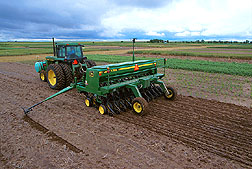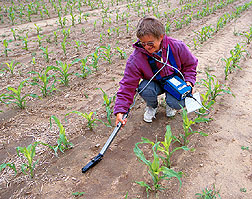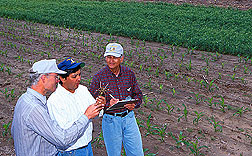On the Central Great Plains—Fallowing Falls by the Wayside
|
|
An aerial view of the Central Great Plains' amber waves of grain shows they are changing dramatically.
Land once left bare every other year is now a quilt of yellows, golds, and earth tones. Since 1990, corn and sunflower acres have increased from few or none to about 140,000. Since 1980, proso millet acres have tripled to 600,000.
The Central Great Plains area comprises about 20 million acres of dryland farms in parts of Colorado, Wyoming, South Dakota, Nebraska, and Kansas. Farmers and ranchers there are paying more attention to recent agricultural research that has proven that a systems approach based on ecological trends in and on the soil may enable them to drastically limit their use of fallow—that is, leaving the soil bare.
Switching to this holistic approach could improve the rural economy across the region by making farming a more sustainable venture over the long haul.
Rainfall on the Central Great Plains averages a mere 14 to 18 inches a year, so growers traditionally alternate a year of rainfed crops with a year of fallow. Precipitation stored in the soil during the fallow year can slake the thirst of the following year's wheat or other crop.
But scientists with the Agricultural Research Service are showing that ecologically based farming practices can provide for crops' water needs with less need for fallow.
"We've improved water use so well, we're nearing our goal of a crop every year," says agronomist Randy L. Anderson, who is at ARS' Central Great Plains Research Station in Akron, Colorado.
|
|
Three Decisive Factors
Reaching this crop-every-year goal is not simple or guaranteed, cautions Akron soil chemist Rudy A. Bowman. "Based on long-term trends, we have observed that three factors are needed before we see soil system changes: soil surface cover with residue, continuous cropping, and no tillage."
What system changes can occur if all three factors are present? "For one thing, we have found that more phosphorus will be available for crops," Bowman says.
Adds biophysicist Robert M. Aiken, "Also, with continuous cropping, organic matter levels in the top 2 inches of soil are 20 percent higher than with wheat-fallow. If the rotation includes fallow, organic matter does not increase." Formerly with ARS, Aiken works at the Kansas State University Experiment Station at Colby.
"We have always recognized that fallow leads to soil erosion and strains farmers' economic resources, since they only get one crop every 2 years," Aiken says. "Now, we can minimize fallow if we design rotations with appropriate crop sequencing."
Team Approach to Solving Problems
The Akron team—Bowman, Anderson, Merle F. Virgil, Joe G. Benjamin, and David C. Nielsen—has been evaluating new crop sequences since 1990. They pool their expertise in weed science, soil physics, soil health, meteorology, soil fertility, and organic matter to gain insights into biological responses of crops, weeds, soils, insects, and soil microbes to crop sequencing.
The Akron team screened more than 20 dryland crop rotation and tillage systems to find the best combinations. Then they compared these rotations to wheat-fallow.
"In the Central Great Plains, farmers' biggest natural obstacle is not having enough water to grow crops continuously," says Nielsen, an agronomist. "That's why they have traditionally left their land bare every other year."
"However, we've found that those wheat-fallow systems use only 40 percent of the average annual rainfall. With continuous cropping, water use approaches 80 percent."
Still, Anderson notes, "producers have to be careful how they sequence crops to avoid crop failure for lack of water. We've found that by using a cycle of four crops, alternating high- and low-water-use crops, they can successfully crop continuously in years with normal or higher precipitation." For example, continuous cropping with wheat-corn-proso millet in rotation doubles the land's productivity, compared to the traditional wheat-fallow.
And in dry years? "We still have to work at rotations that succeed in dry years," admits Virgil, a soil scientist. "One option we're exploring is to include forage crops or green fallow. Both use less water than the current crops—wheat, corn, millet, and sunflowers."
The team discovered that crop sequencing can sometimes increase yields. "For example," says Anderson, "we found that corn is beneficial to a following crop of proso millet or sunflower." And they found that a broadleaf crop like sunflower also improves yields of the following crop.
But sunflowers yielded most when grown only once every 4 years, the team found. "More frequent cropping than this favored the buildup of soilborne diseases," says Benjamin, a soil physicist.
Wheat, corn, and proso millet yields were also higher with a longer interval between replanting.
The scientists are investigating reasons for these yield increases. "They may be due to changes in soil microbe communities, such as increases in mycorrhizae when corn is grown," says Bowman.
These results led the scientists to develop rotations based on the 4-year cycle. "By diversifying crops in the rotation," says Bowman, "the farmer encourages more diverse soil microflora. And soils with a diversity of microorganisms have a natural antagonism to soilborne crop diseases." In the end, the diversity of crops and microbial populations makes the ecosystem more sustainable over the long haul.
This notion of diversity extends even to crop roots. The team found that rooting depth and types of roots of crops can vary considerably—even within the same field.
"Farmers can take advantage of these differences to grow the best crops for the soil and environmental conditions," says Aiken. "They can plan rotations to improve root health so roots explore a greater volume and depth of soil. This improves the overall efficiency of roots in taking up fertilizer at various soil depths."
The cycle of four crops—two winter crops followed by two summer crops—also minimizes weed densities, says Anderson. This approach may help growers reduce pesticide use and subsequently production costs.
"The wheat-fallow system strains farmers' economic resources because its high cost exceeds the income derived from it. Government payments now subsidize the low-income wheat-fallow system. With the end of government payments in 2002, this system will be a financial loser," says Colorado State University economist Dennis A. Kaan, who works at Akron with the team.
"We've found that alternative rotations can be 20 to 40 percent more profitable—especially if they include corn or sunflowers," Kaan says. "Both crops are high water users, so our goal is to understand how they can be sequenced with low-water-use crops to ensure that we do not exceed our water limits."—By Hank Becker, Agricultural Research Service Information Staff.
This research is part of Soil Resource Management, an ARS National Program (#202) described on the World Wide Web at http://www.nps.ars.usda.gov/programs/nrsas.htm.
Randy L. Anderson and other ARS scientists mentioned in this article are at the USDA-ARS Central Great Plains Research Station, 40335 County Rd. GG, Akron, CO 80720; phone (970) 345-2259, fax (970) 345-2088.









